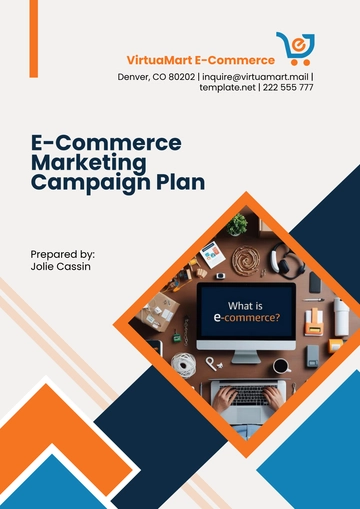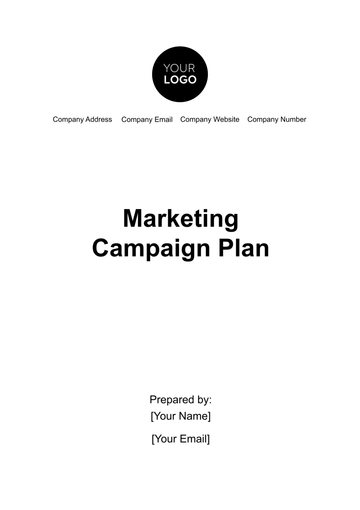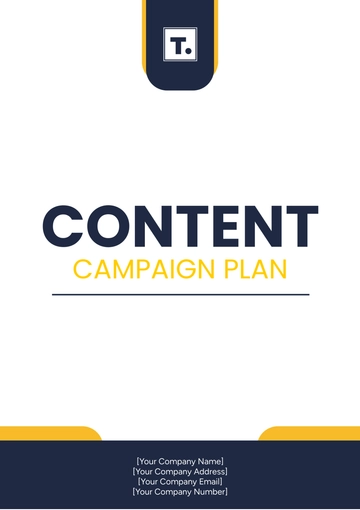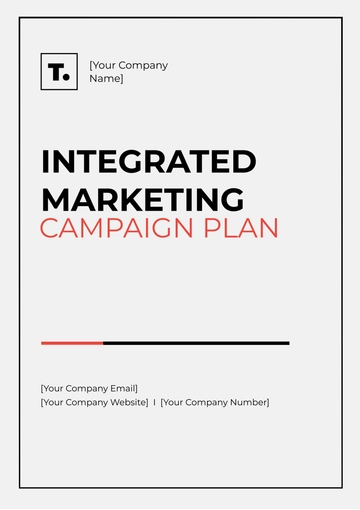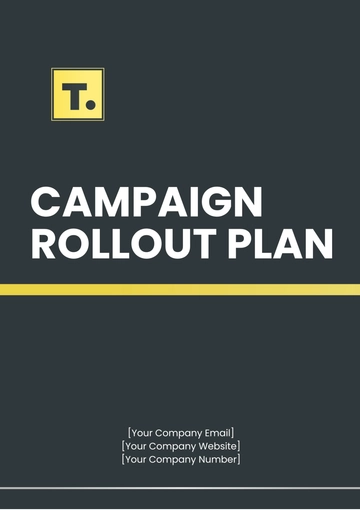Free Email Marketing Drip Campaign Plan

I. Campaign Overview
A. Objective
The goal of [Your Company Name]'s campaign is to nurture new subscribers who have signed up for our newsletter and encourage them to make their first purchase. Over the course of 7 emails, we will educate them about our products, showcase customer testimonials, and offer exclusive discounts to drive conversions. Our aim is to achieve a 25% open rate, 10% click-through rate, and a 5% conversion rate for the campaign.
B. Target Audience
The campaign will target new subscribers who joined our mailing list in the past 30 days. We will focus on individuals aged 25-45 who are interested in lifestyle products like skincare and wellness. Subscribers will be segmented by their geographic location, as we are currently offering free shipping to the United States.
C. Key Metrics
To measure the success of this campaign, we will track the following metrics:
Metric | Target | Current Baseline |
|---|---|---|
Open Rate | 25% | 18% |
Click-through Rate | ||
Conversion Rate | ||
Unsubscribe Rate |
II. Email Sequence
A. Number of Emails
This campaign will consist of 7 emails, sent over 14 days, with the first email sent immediately after sign-up. The goal is to progressively engage the subscriber with value-driven content and calls to action to purchase our products.
B. Email Content Plan
Email # | Content Focus | Call-to-Action (CTA) |
|---|---|---|
1 | Welcome Email + Brand Introduction | “Shop Now” |
2 | How Our Products Benefit You | “Explore Our Collection” |
3 | Educational Email on Skincare Tips | “Get Your Free Guide” |
4 | Customer Testimonials and Social Proof | “See More Reviews” |
5 | Exclusive Discount Offer | “Use Code SAVE10 for 10% Off” |
6 | Product Spotlight: Bestsellers | “Shop Our Bestsellers” |
7 | Final Reminder: Limited-Time Offer | “Claim Your Discount Today” |
C. Email Trigger Points
Email 1: | Sent immediately upon sign-up. |
Email 2: | Sent 2 days after Email 1. |
Email 3: | Sent 4 days after Email 2. |
Email 4: | Sent 5 days after Email 3. |
Email 5: | Sent 2 days after Email 4. |
Email 6: | Sent 3 days after Email 5. |
Email 7: | Sent 2 days after Email 6. |
III. Audience Segmentation
A. Behavioral Segmentation
Subscribers will be segmented based on actions such as whether they opened previous emails, clicked on the CTA buttons, or added products to their cart. For example, users who did not open the first two emails will receive a slightly altered subject line and a special offer to encourage engagement.
B. Demographic Segmentation
We will segment subscribers based on their location, focusing on U.S.-based users who qualify for free shipping. Additionally, subscribers aged 30-40 will receive product recommendations aligned with their interests, such as anti-aging skincare.
C. Custom Segmentation
For high-value customers who have previously purchased, we will offer a special VIP discount in the email sequence. These users will be added to a segment labeled “VIP Customers,” and will receive emails tailored to their past purchase behaviors, encouraging repeat sales.
IV. Email Content and Messaging Strategy
A. Tone and Voice
The tone of the emails will be friendly, professional, and empathetic, aiming to build a relationship with subscribers. We will use inclusive language that makes readers feel like they are part of a community, positioning our brand as a trusted partner in their skincare journey. The voice will reflect expertise but remain approachable, offering helpful advice without sounding overly formal or promotional.
B. Personalization
Personalization will extend beyond just the subscriber's name in the subject line. Each email will include personalized product recommendations based on browsing history or past purchases, which will increase the likelihood of engagement. We will also personalize the timing and frequency of the emails, adjusting based on the user's activity (e.g., sending follow-up emails after certain actions like abandoned cart).
C. Value Proposition
Each email will clearly communicate the value proposition of our products, focusing on benefits such as premium ingredients, sustainability, and their efficacy in improving users’ lifestyles. For instance, in the educational email, we will offer skincare tips and how our products help address common skincare concerns like dryness or aging. Every email will reinforce the long-term benefits of using our products, ensuring that customers feel informed and confident in their purchases.
D. Call-to-Action (CTA)
The CTA will be strategically placed in each email to make it easy for subscribers to take the next step. For example, in the educational email, the CTA might be "Get Your Free Skincare Guide," which allows us to offer value and keep the subscriber engaged. In the promotional emails, the CTA will emphasize urgency, like "Shop Now and Save 10%" to encourage immediate action.
V. Email Design and Layout
A. Visual Elements
The email will feature vibrant, high-quality images that showcase our products in use, creating a sense of lifestyle aspiration. For example, images of our skincare products alongside a serene, natural background will evoke a sense of calm and wellness. We will also include before-and-after product images and infographics that highlight key benefits to make the content more engaging and informative.
B. Responsive Design
Our emails will be designed to be fully responsive, ensuring a seamless experience whether viewed on mobile, tablet, or desktop devices. We will use a single-column layout that adjusts to screen size, making it easy for subscribers to read and click on links regardless of their device. To avoid clutter, text and images will be optimized for smaller screens, ensuring that mobile users have an enjoyable reading experience.
C. Brand Consistency
Consistency in branding will be a priority across all emails, reinforcing brand recognition and trust. Our emails will feature our logo prominently in the header and footer, along with a cohesive color scheme that aligns with our website and social media channels. Typography will follow our brand guidelines, ensuring that all emails are visually cohesive and reinforce our established brand identity.
VI. Email Timing and Frequency
A. Timing of Email Sends
We will conduct A/B testing to identify the best time of day for email sends. Our initial hypothesis is that emails sent at 10 AM EST will have higher open rates, as this aligns with common peak engagement times. If the testing shows that later times or weekends perform better, we will adjust the send times to match subscriber behavior.
B. Frequency of Emails
The frequency of emails will be balanced to maintain engagement without overwhelming subscribers. For example, in the first 5 days, subscribers will receive emails on days 1, 3, and 5, then follow-up emails will be spaced out to every 3 days. This strategy ensures that subscribers remain engaged while still giving them time to digest the content of each email.
C. Send Window
The campaign will run for 14 days, but we will monitor engagement closely to ensure that it is not too short or too long. If we see high engagement rates towards the end of the campaign, we may extend the campaign by another week or offer a final reminder email to increase conversions. This flexibility allows us to adjust in real time for optimal results.
VII. Automation and Technical Setup
A. Email Marketing Platform
We will use Mailchimp as our email marketing platform, which provides robust automation features and detailed reporting. Mailchimp allows for easy segmentation and personalized email delivery, based on triggers such as sign-up date, product interest, or past behavior. The platform also integrates with our website to track user activity, which helps in sending targeted emails based on their actions.
B. Triggers and Workflows
The email sequence will be triggered by specific user actions such as signing up for the newsletter, browsing products, or abandoning a cart. For example, if a user abandons their cart, an automated email will be sent within 24 hours offering a discount code to encourage them to complete their purchase. Additionally, workflows will be set up to adjust email frequency and timing based on user interactions, ensuring relevance and engagement.
C. Segmentation Rules
We will set up segmentation rules based on user behavior, such as users who opened the first email but did not click the CTA or those who made a purchase after receiving a promotional email. This segmentation allows for more targeted follow-up, offering different incentives or content depending on their stage in the customer journey. For example, cart abandoners will receive a different message than users who clicked through but did not purchase.
VIII. A/B Testing and Optimization
A. Test Variables
A/B tests will be conducted on key variables such as subject lines, email design, and CTA wording. For instance, we will test whether urgency-driven subject lines like "Limited Time Offer" lead to higher open rates compared to more benefit-oriented subject lines like "Unlock Your Skincare Potential." Testing different visuals and layouts will also help us determine the most effective way to showcase products in the email.
B. Testing Schedule
The A/B testing will be conducted on the first three emails in the series to optimize for better performance. Testing will focus on subject lines, CTA placement, and overall email layout. Based on the results of these tests, we will apply the findings to optimize the next emails in the series to improve open rates, clicks, and conversions.
C. Data Analysis and Iteration
Once we have gathered enough data from the A/B tests, we will analyze the performance of each version to determine which performed better in terms of engagement metrics. If one variant significantly outperforms the other, we will use that version as the default for the rest of the campaign. Continuous optimization will ensure that the campaign remains effective and relevant to the audience throughout its duration.
IX. Compliance and Best Practices
A. Legal Requirements
We will ensure full compliance with email marketing laws such as GDPR, CAN-SPAM, and the CCPA. Each email will include an easy-to-find unsubscribe link, and personal data will only be used in accordance with the privacy policy. We will also include a brief disclaimer at the bottom of emails regarding how we collect and use data.
B. Unsubscribe Options
A clear and visible unsubscribe link will be included in the footer of every email. This allows subscribers to opt-out of the campaign if they no longer wish to receive marketing communications, ensuring that we maintain a good relationship with our audience while remaining compliant with legal standards. Unsubscribed users will be removed from the campaign automatically.
C. Privacy and Data Protection
We will take all necessary steps to protect user data, including using secure platforms and encryption methods for email delivery and storage. Our privacy policy will be clearly outlined in every email, reassuring subscribers that their data is being handled with the utmost care. We will also limit the use of personal data, ensuring it is only used for relevant and specific marketing purposes.
X. Performance Tracking and Reporting
A. Key Metrics to Track
The following metrics will be tracked to evaluate the success of the campaign:
Metric | Goal | Actual (Post-Campaign) |
|---|---|---|
Open Rate | 25% | 22% |
Click-Through Rate | ||
Conversion Rate | ||
Unsubscribe Rate |
B. Reporting Frequency
Performance will be reviewed every 3 days to ensure the campaign is on track to meet the established goals. At each checkpoint, we will adjust strategies based on real-time data, optimizing the campaign for the best possible results. After the campaign concludes, a final report will be generated to assess overall success and identify areas for improvement in future campaigns.
C. Campaign Adjustments
Based on early data, we will tweak the subject lines, CTAs, and email frequency as needed. For instance, if open rates are lower than expected, we may experiment with different subject lines or email send times. By analyzing key metrics like open rates, click-through rates, and conversions, we can make informed adjustments that optimize the campaign as it progresses.
- 100% Customizable, free editor
- Access 1 Million+ Templates, photo’s & graphics
- Download or share as a template
- Click and replace photos, graphics, text, backgrounds
- Resize, crop, AI write & more
- Access advanced editor
Prepare to streamline your email marketing strategy with the Email Marketing Drip Campaign Plan Template from Template.net. This fully editable and customizable template allows you to craft targeted email sequences effortlessly. With the AI Editor Tool, you can quickly tailor content to your audience, saving time while ensuring effective and engaging campaigns.
You may also like
- Finance Plan
- Construction Plan
- Sales Plan
- Development Plan
- Career Plan
- Budget Plan
- HR Plan
- Education Plan
- Transition Plan
- Work Plan
- Training Plan
- Communication Plan
- Operation Plan
- Health And Safety Plan
- Strategy Plan
- Professional Development Plan
- Advertising Plan
- Risk Management Plan
- Restaurant Plan
- School Plan
- Nursing Home Patient Care Plan
- Nursing Care Plan
- Plan Event
- Startup Plan
- Social Media Plan
- Staffing Plan
- Annual Plan
- Content Plan
- Payment Plan
- Implementation Plan
- Hotel Plan
- Workout Plan
- Accounting Plan
- Campaign Plan
- Essay Plan
- 30 60 90 Day Plan
- Research Plan
- Recruitment Plan
- 90 Day Plan
- Quarterly Plan
- Emergency Plan
- 5 Year Plan
- Gym Plan
- Personal Plan
- IT and Software Plan
- Treatment Plan
- Real Estate Plan
- Law Firm Plan
- Healthcare Plan
- Improvement Plan
- Media Plan
- 5 Year Business Plan
- Learning Plan
- Marketing Campaign Plan
- Travel Agency Plan
- Cleaning Services Plan
- Interior Design Plan
- Performance Plan
- PR Plan
- Birth Plan
- Life Plan
- SEO Plan
- Disaster Recovery Plan
- Continuity Plan
- Launch Plan
- Legal Plan
- Behavior Plan
- Performance Improvement Plan
- Salon Plan
- Security Plan
- Security Management Plan
- Employee Development Plan
- Quality Plan
- Service Improvement Plan
- Growth Plan
- Incident Response Plan
- Basketball Plan
- Emergency Action Plan
- Product Launch Plan
- Spa Plan
- Employee Training Plan
- Data Analysis Plan
- Employee Action Plan
- Territory Plan
- Audit Plan
- Classroom Plan
- Activity Plan
- Parenting Plan
- Care Plan
- Project Execution Plan
- Exercise Plan
- Internship Plan
- Software Development Plan
- Continuous Improvement Plan
- Leave Plan
- 90 Day Sales Plan
- Advertising Agency Plan
- Employee Transition Plan
- Smart Action Plan
- Workplace Safety Plan
- Behavior Change Plan
- Contingency Plan
- Continuity of Operations Plan
- Health Plan
- Quality Control Plan
- Self Plan
- Sports Development Plan
- Change Management Plan
- Ecommerce Plan
- Personal Financial Plan
- Process Improvement Plan
- 30-60-90 Day Sales Plan
- Crisis Management Plan
- Engagement Plan
- Execution Plan
- Pandemic Plan
- Quality Assurance Plan
- Service Continuity Plan
- Agile Project Plan
- Fundraising Plan
- Job Transition Plan
- Asset Maintenance Plan
- Maintenance Plan
- Software Test Plan
- Staff Training and Development Plan
- 3 Year Plan
- Brand Activation Plan
- Release Plan
- Resource Plan
- Risk Mitigation Plan
- Teacher Plan
- 30 60 90 Day Plan for New Manager
- Food Safety Plan
- Food Truck Plan
- Hiring Plan
- Quality Management Plan
- Wellness Plan
- Behavior Intervention Plan
- Bonus Plan
- Investment Plan
- Maternity Leave Plan
- Pandemic Response Plan
- Succession Planning
- Coaching Plan
- Configuration Management Plan
- Remote Work Plan
- Self Care Plan
- Teaching Plan
- 100-Day Plan
- HACCP Plan
- Student Plan
- Sustainability Plan
- 30 60 90 Day Plan for Interview
- Access Plan
- Site Specific Safety Plan






